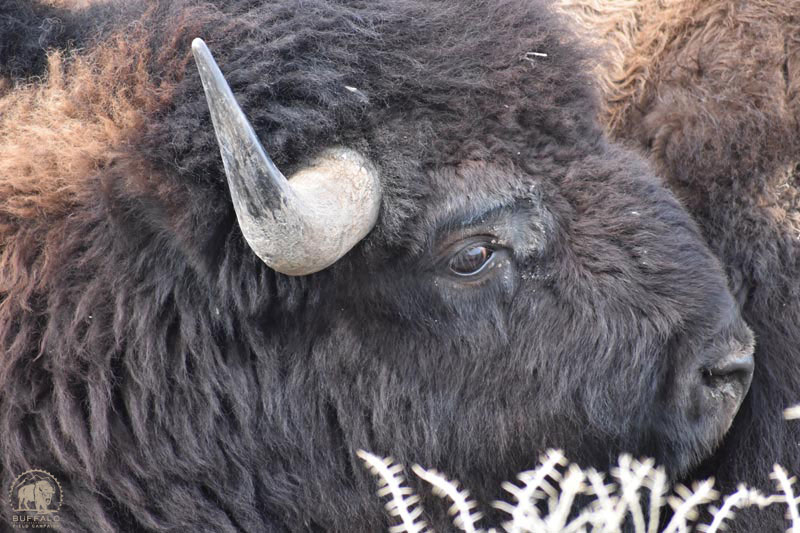More than 1,200 of America’s last wild buffalo have been killed this winter, and it isn’t over yet. Hunting along Yellowstone’s boundaries has taken the lives of more than 400 buffalo. Hunters are still in the field making kills. It’s a terrible time of year to hunt. The buffalo — like other wild grazers — have used up all of their fat stores, and are showing ribs and bony hips, waiting for the re-greening of the Earth so they can again replenish their huge bodies. This is also the time of year when the long, harsh winter takes her toll, too. There will be many buffalo who will not survive into spring, but the government is not accounting for these deaths in their mad rush to reduce this most significant and vulnerable population. Further, hunters are still killing adult female buffalo who will begin having their calves in about six weeks. All too often, BFC patrols make heartbreaking discoveries of finding fully-formed baby buffalo in their mother’s gut piles.
Additionally, Yellowstone National Park — shamefully complicit in Montana’s livestock industry’s war against wild buffalo — has captured close to 800 buffalo, all of whom have been or will be sent to slaughter. The trap is emptying quickly, though Yellowstone continues to attempt to capture. Recently, some buffalo have resisted these attempts, while others have not been so lucky. On Monday in Gardiner, BFC patrols documented as five Yellowstone wranglers on horseback tried to trap fifty-five buffalo; all but one got away, running to the hills for their lives. The unfortunate mama buffalo who was trapped caught the attention of another family group of twenty-two. Coming dangerously close to the trap, they sealed their own fate as the wranglers, hungry to capture, took advantage of the situation. Hundreds of wild buffalo are gone forever. BFC’s Mike Mease and Stephany Seay attended the second media tour of Yellowstone’s trap last Thursday, where we again witnessed Yellowstone park rangers, wranglers, and biologists doing the service of the Montana Department of Livestock as they loaded wild buffalo onto stock trailers headed for the slaughterhouse, then proceeded to move more through the trap. It has become business as usual for these buffalo abusers, just another day in the park. They tell us that they don’t like doing this, that they want slaughter to end, but their actions say something else. Yellowstone National Park is not without significant power, but they have shown they are without courage. They can stand up to Montana and refuse to participate. But they don’t. Their cold routine of capturing, testing, sorting, and shipping the country’s national mammal to a horrific death — as they don the image of this sacred being on their uniforms and rake in millions from the people who come to adore them — has become just another day at work. They attempt to put the task of change on the public, shirking responsibility for their part in these crimes. While it is true that a current Montana law - MCA 81-2-120 — is the driver behind the cumulative mismanagement plans and practices, Yellowstone should not have the luxury of of passing the buck. The world’s most well-known national park has astounding influence that they choose not to use. Instead, they kill America’s last wild buffalo. By the end of March, this should all be over.
Please continue to keep pressure on Montana and Yellowstone. Do not ease up. Be relentless and don’t accept their excuses. Laws, decisions, and management plans can be changed.
* Yellowstone National Park Superintendent Dan Wenk 307-344-2002
* Montana Governor Steve Bullock 406-444-3111
And contact your members of Congress to tell them that this must end once and for all. Congress holds the purse strings and can end the funding.
The coming of spring is beginning to benefit the buffalo, and we are thankful. The Gardiner Basin is swiftly losing all of its snow and the earth is beginning to turn green again. This is encouraging buffalo to migrate away from the vicinity of the trap and away from the boundary where hunters still wait. In the Hebgen Basin, west of the park, however, there is still a significant amount of snow covering the ground. It’s beginning to melt, and south-facing slopes are opening up, but with so much snow there’s still a long way to go. Buffalo here are making their living along creeks and rivers, eating the sedges that are exposed. Soon spring migration will begin in earnest, as family groups — hopefully by the hundreds — will make their way to their calving grounds around Horse Butte. BFC patrols will soon shift our focus to the highway, helping to warn motorists as the buffalo move through this important corridor to their birthing grounds. The Montana Department of Transportation has recently installed new 55mph signs for night time drivers, but without enforcement this change will not benefit buffalo very much. A few other mitigation measures have been or will soon be put into place as well, including new wording on three marquee signs that alert drivers to “BISON” on the road, as well as an incident alert for a mobile app to alert truckers and other travelers that they should expect buffalo on the road along this section of highway. These things will help, but safe passage infrastructure is the only thing that will make a real and lasting difference. Until then, and as we always are, BFC will be out day and night helping to warn traffic, trying to keep the buffalo safe.



